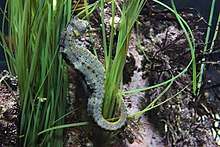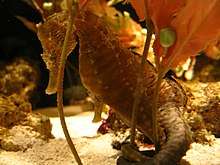Pacific seahorse
| Pacific seahorse | |
|---|---|
 | |
| Scientific classification | |
| Kingdom: | Animalia |
| Phylum: | Chordata |
| Class: | Actinopterygii |
| Order: | Syngnathiformes |
| Family: | Syngnathidae |
| Genus: | Hippocampus |
| Species: | H. ingens |
| Binomial name | |
| Hippocampus ingens Girard, 1859 | |
| Synonyms[2] | |
The Pacific seahorse, also known as the giant seahorse, (Hippocampus ingens) is a species of fish in the family Syngnathidae. This species is the only seahorse species found in the eastern Pacific Ocean.[3]
Description

Adult pacific seahorses range in size from 12 to 19 centimetres (4.7 to 7.5 in) in height, with a maximum known size of 30 centimetres (12 in). Offspring are approximately 9 mm after birth. Pacific seahorses can be a variety of colors, including green, brown, maroon, grey, and yellow. Males can be distinguished from females by their prominent keel.[4]
Pacific seahorses share the common traits of seahorses, including a prehensile tail used for anchoring, skin instead of scales, a digestive tract without a distinct stomach, no teeth, and the ability to move each eye independently.[5]
Distribution and habitat
The pacific seahorse is distributed in the Pacific Ocean from Baja California to Peru, with an additional transient population off of San Diego.The only known oceanic island population occurs around the Galapagos Islands.[3]
Pacific seahorses are known to inhabit a variety of sub-tidal habitats to a maximum depth of 60 metres (200 ft).[5] Habitats include mangroves, seagrass meadows, rocky reefs, coral reefs and sponges.[3][5]
Reproduction and development
Female pacific seahorses in captivity have been observed producing small broods at three months of age. Sexually mature females often develop a dark patch below the anal fin. Males reach sexual maturity at around 5.4 centimetres (2.1 in) in height. Unsuccessful reproductive activity in captivity has been noted at around three months of age, with successful pregnancies as early as six months of age.[4]
Like all seahorses, females deposit their eggs in the brood pouch of the male, where they are subsequently fertilized by the male and sealed into the pouch. As the embryos develop, the fluid inside the pouch changes in salinity to acclimate the embryos to the salinity of the surrounding sea water. Research suggests that pacific seahorse males can brood up to 2000 eggs at once, and may brood multiple times in a breeding season. At the end of the fourteen day gestation period, the male goes into labor and must force the young out of the pouch one at a time, sometimes taking hours.[4][5]
Birth marks the end of parental care, as young are born fully self-sufficient. It has been hypothesized that the juveniles spend the first few months after birth in the open ocean. This is based on their large juvenile dorsal fin and lack of juvenile anchoring behavior, and not specific field observation.[4]
Evolutionary history
The lineage of seahorses leading to modern pacific seahorses diverged from slender seahorses after the rise of the Isthmus of Panama, between 4 and 5 mya. Pacific seahorses and Fisher's seahorses split from this lineage 2.5 to 3 mya.[3]
Conservation status

Pacific seahorses face many of the same threats that other seahorses face; over 20 million seahorses are sold each year to be used in Chinese medicine, the aquarium trade, or dried as curios. Mexico and Peru are the largest exporter of pacific seahorses, selling more than 1 dry ton annually.[3] Seahorses are particularly susceptible to over-harvesting due to characteristics such as low fecundity, monogamous mating, long development of embryos, low dispersal ability, and limited geographic distribution.[5] Habitat degradation also poses a threat to pacific seahorses. In 2004, the entire genus Hippocampus was included in appendix II of CITES.[5]
References
- ↑ Pollom, R. (2017). "Hippocampus ingens". The IUCN Red List of Threatened Species. 2017: e.T10072A54905720. Retrieved 19 May 2018.
- ↑ Froese, Rainer and Pauly, Daniel, eds. (2018). "Hippocampus ingens" in FishBase. February 2018 version.
- 1 2 3 4 5 Saarman, Norah; Louie, Kristina; Hamilton, Healy (2010). "Genetic differentiation across eastern Pacific oceanographic barriers in the threatened seahorse Hippocampus ingens". Conservation Genetics. 11: 1989–2000. doi:10.1007/s10592-010-0092-x.
- 1 2 3 4 Gomezjurado, Jorge (2005). "Pacific Seahorse, Hippocampus ingens". Synthnathid Husbandry in Public Aquariums Manual.
- 1 2 3 4 5 6 Foster, S.J.; A.C.J., Vincent (2004). "Life history and ecology of seahorses: implications for conservation and management". Journal of Fish Biology. 65: 1–61. doi:10.1111/j.0022-1112.2004.00429.x.
